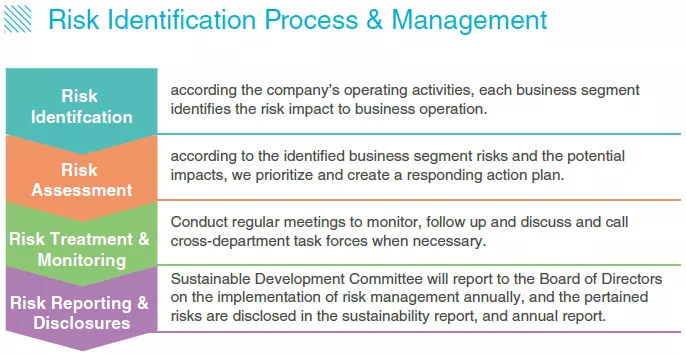
Operational Aspect
- Procurement Risk
- For our soybean supply, we import from North America, South America, Europe and Asia to minimize the disruptions in the supply chain.
- Our domestic procurement follows our Supplier Management Policy to ensure product delivery and quality. We also value the supplier's implementation in the ESG aspects.
- Carry safety stock inventory and insure inventory (fire insurance & inventory insurance).
- Implement sustainable procurement, increase the purchase volume in SSAP soybean from the US, RSPO palm oil and FSC cardboard boxes to reduce carbon emissions and energy conservation.
- Occupational Safety Risk
- Establish Occupational Safety Committee task force to adopt ISO 45001 and TOSHMS and conduct regular meetings, implement occupational safety and hygiene issues.
- Conduct related training courses in occupational safety to raise the awareness and preventive actions.
- Cybersecurity Risk
- Install firewall to prevent cyber hacking into the data server system and install antivirus software to all the company computers and update regularly.
- Install UPS to ensure information technology to continue to operate in case of power outage; use offsite data server center as a duplicate backup server system to minimize cybersecurity risk.
- We subscribe to cyber protection with the telecommunication company and information security vendor to further implement and monitor cyber and information security. Conduct regular training drills to test the effectiveness and ensure all measures are taken in information security.
Financial Aspect
- Market Risk
- Credit Risk
Through the "Customer Credit Line Management Policy", each customer's credit is rated; the credit line is evaluated quarterly. Strict control measures are implemented for customers exceeding their credit limits, and request additional collateral if necessary to reduce credit risk.
- Liquidity risk
- Cash flow risk caused by interest rate fluctuation
Health Aspect
- Food Safety Risk
Strategic Aspect
- Climate Change Risk
- Sets and monitors strategy and risk assessment; responsible for establishing the company's mid- to long-term climate change management strategies both in risks and opportunities; and financial impacts.
- Establish an Energy Management Task Force to complete the self-assessment of quantification of greenhouse gas emissions at Taichung Harbor plant, Shalu plant, and Lukang plant and undergo verification via an independent third-party.
- Water Resource Risk
- At the time of plant establishment, water-saving standards were included. Regular inspections are conducted to check for any malfunction or leakage in the water facilities.
- Various water resource applications, including tap water, recycled water, groundwater. In the event of water restrictions, we will resort to purchasing water to meet our needs.
- To meet the discharge standards, wastewater is treated prior to being recycled for further use, thereby enhancing water resource utilization efficiency.
- In the event of a drought and water scarcity crisis, a crisis management team will be established to proactively adjust the production scheduling as a preventive measure.



